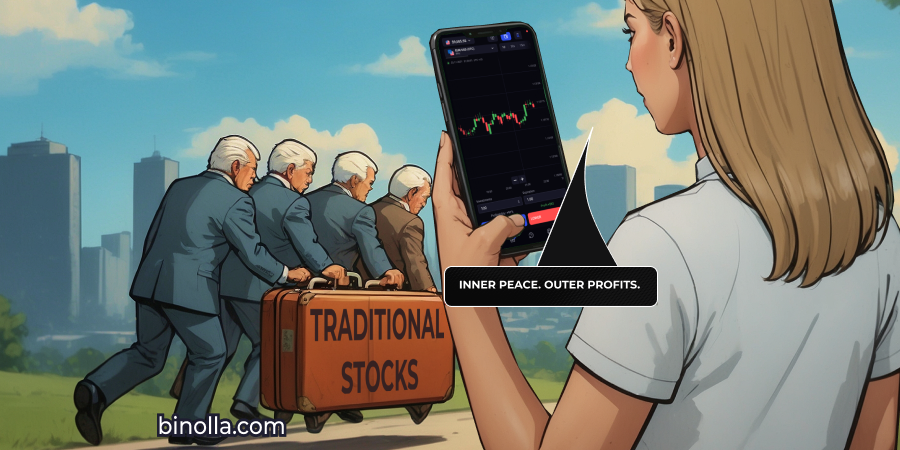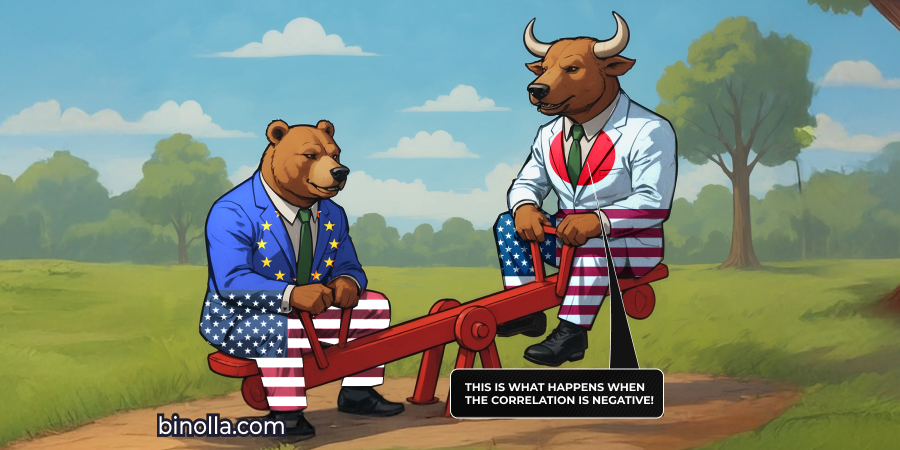Digital Options Trading Explained

Digital options trading is very popular nowadays for many reasons. Those contracts are considered among the most suitable for beginners because of their simplified nature. Moreover, one single trade may bring you up to a 95% (and sometimes even higher) payout. This means that you can almost double your investment amount by forecasting the right direction of price movement. By reading this article, you will learn more about digital options trading and the main features of those contracts, and we are going to provide you with some useful tips. Create an account at Binolla to enjoy all the benefits of this financial instrument.
Contents
Back in Time
Digital options have quite a long history. Even if they are the latest contracts, if you compare them to the stock market or FX, they have been traded for over 15 years now. With those derivatives, many new traders managed to enter the industry and make their first steps in the financial markets.
The first digital options trading orders were placed in 2008. If you went back in time, you would see that 2008 was the year of the beginning of the global financial crisis when several US banks burst, which caused major damage to the global financial system.
All those events laid the groundwork for two outcomes. First, a lot of new people came into financial markets as they were looking for additional sources of income due to financial instability in the US and in other parts of the world. Second, such simplified contracts as digital options appeared to provide a kind of onboarding into the financial markets for those newcomers.
Where do Digital Options Derive from?
Digital options trading did not appear from scratch. Those contracts are derived directly from classic or vanilla options, with some more simplified rules and wider accessibility. Classic options themselves were first mentioned by Aristotle in his monumental work “Politics.” You will be surprised to know that this mention is dated 332 BC! While those weren’t the contracts that you can trade today on options exchanges, Aristotle described the concept of buying rights to a particular asset and transferring them without purchasing the asset.
Modern classic options appeared with the establishment of the CBOE (Chicago Board Options Exchange), which opened its doors in 1973. Vanilla options have been traded actively since.
When it comes to digital options, they are not direct heirs of traditional options. They are derivatives of derivatives, so to speak. While those digital contracts preserved the name “option” and some traits of vanilla derivatives such as strike price and expiration, as well as their type names (Call and Put were initial names for digital options contracts for those who expected the underlying asset to grow or plunge), traditional options are much more complex than the digital ones.
Those who invented fixed-time contracts had beginners in mind. If you want to join financial markets and you don’t know anything about trading, then you can try digital options trading, which is one of the most understandable types of contracts so far. That was the idea that managed to grow into a whole industry, which counts millions of US dollars nowadays.
Digital options trading has several aspects in common with vanilla options. In particular, there is a strike price and expiration in both types of contracts. Therefore, all types of options have a certain period in the future when the settlement takes place.
The difference between those contracts lies in the fact that traditional options trading is more complex and is suitable for those who have already had some experience. In particular, when it comes to digital options trading, those contracts are designed to predict the price movement direction. Therefore, there are only two options in those contracts. You are either right or wrong.
When it comes to classic options, there are many more ways to make money and several outcomes of a single trade. However, with those additional features, the complexity increases.
Digital Options Explained
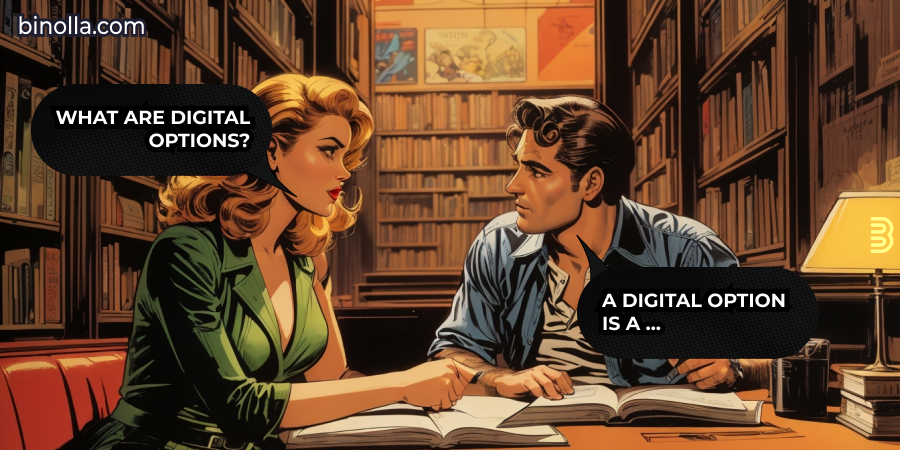
Now that you know the history of those derivatives, it is time to delve deeper into their nature and see what digital options trading is and how those contracts work.
We have already underlined the simplified nature of digital option trading. It is true that those derivatives are easier to deal with when it comes to technical options trading procedures. When you buy a particular contract, you have only two possible outcomes: the contract can either be in the money (which means that you will be paid) or out of the money, when you make the wrong prediction.
Therefore, when performing digital options trading, you should only think about the direction of the price movement. If you buy a Higher derivative, you expect the underlying asset’s price to surge as compared to when you purchase a contract (strike price). When buying a Lower contract, you, on the contrary, expect the underlying asset’s price to plunge from its initial value (strike price).
Expiration
Expiration is a very important part of digital options trading. It defines an exact moment in the future when a contract expires or simply when the calculations are made. If your forecasts are right, you will be paid out at the moment of the option’s expiration. On the other hand, if you were wrong, you would lose the investment amount, which would be deducted from your balance.
With various types of expirations, you can cover almost all possible trading styles. In particular, you can buy 5s SCalping contracts that are available on the Binolla platform and have the shortest possible option trading that concludes in the next five seconds.
Along with scalping, you can also trade short- and even mid-term options contracts. Everything depends on your style and preferences. If you need time to analyze markets and want to earn on more stable price fluctuations, you can choose mid- and long-term options trading derivatives, while for those who feel well with the market noise, short-term contracts are the best choice.
Amount of Investments
Another important aspect of digital options is the amount of investment. You choose it on your own, like with any other type of financial instrument. There is a golden rule in trading that says that the investment amount should not exceed 5% of your total balance. If you have $100 on your balance, for instance, you should not trade with more than $5. For those with $1,000, this amount can be no more than $50.
Choosing the Right Direction
That’s the most complex part of digital options trading. Similar to any other financial instrument, the goal of these derivatives is to predict the direction of price movement. Before buying a particular contract, you should conduct a market analysis. To make it clear, we are going to provide you with some useful recommendations and examples below.
Digital options are not only the most understandable and simplified financial instruments. They are also among the fastest ones. Therefore, fundamental analysis is not the right tool to predict price fluctuations in this case. You can use news trading strategies, but keep in mind that they are risky and it is better to rely on technical analysis first.
The latter works with charts and prices directly. The idea of technical analysis is to predict future price movement directions using historical chart data. Here are some examples of how you can perform digital options trading using basic technical strategies.
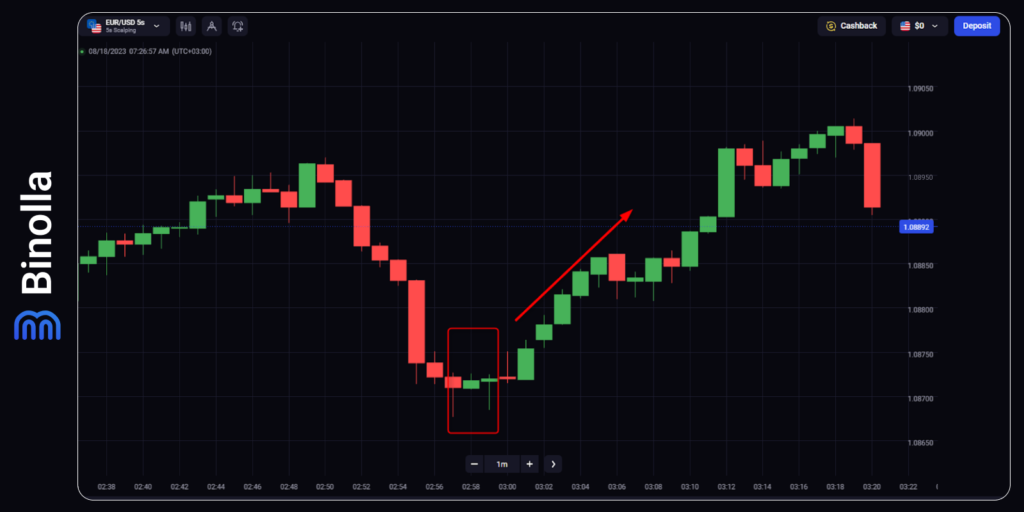
One of the simplest strategies that you can use when performing digital options trading is the hammer pattern. The idea here is to find a candlestick with a long lower wick and a small body with almost no upper wick. As you can see on the chart, once two hammers appear, the price direction changes. This is a great opportunity for traders to buy a Higher option.
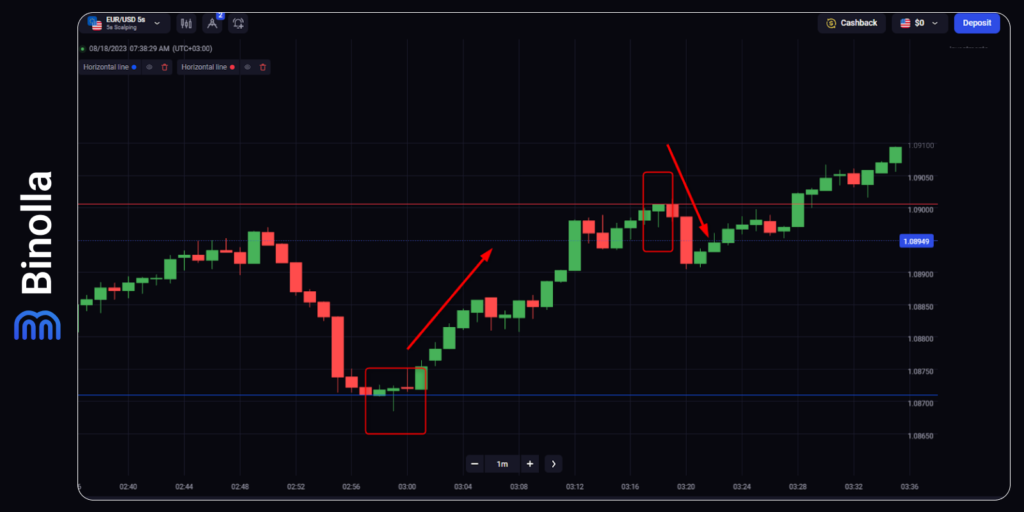
Keep in mind that hammers are formed on the support level only! If you see the same pattern with a long lower tail and a small body with almost no upper tail that appears close to resistance, this will not work the same way as this one, known as the hanging man, and this is a totally different type of pattern that foreshadows the end of price growth and its reversal.
By the way, trading with Hanging Man is also very simple and straightforward. When you perform digital options trading and notice that this pattern appears on charts, you can buy a Lower contract once this candlestick closes.
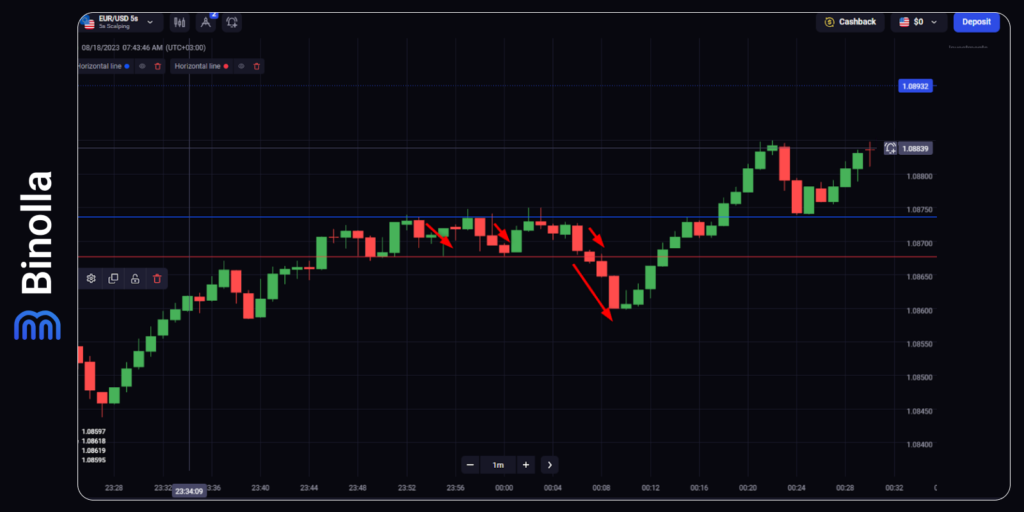
Range trading is very popular among digital options traders. One of the advantages of those contracts is that to make up to 95% of your investment amount, you don’t necessarily need to catch huge price movements. Sometimes it is enough to have only one pip above or below the strike price to profit.
Range trading strategies assume that the price will remain between two levels for some time. Once it approaches the upper band of the range, you can expect it to reverse, and once this happens, you can buy a lower contract. On the other hand, if the price touches the lower band and reverses, you can buy a Higher contract to profit from this particular situation.
That is as simple as it sounds. However, there is one more interesting strategy that you can use during the range price movement. Ranges are not eternal, and they end at some point as the price leaves them. At this exact moment, you can profit by buying a digital contract. In our example, the price breaks the support line. If you wait for the confirmation (the candlestick should close), you can buy a Lower contract and profit from this situation.
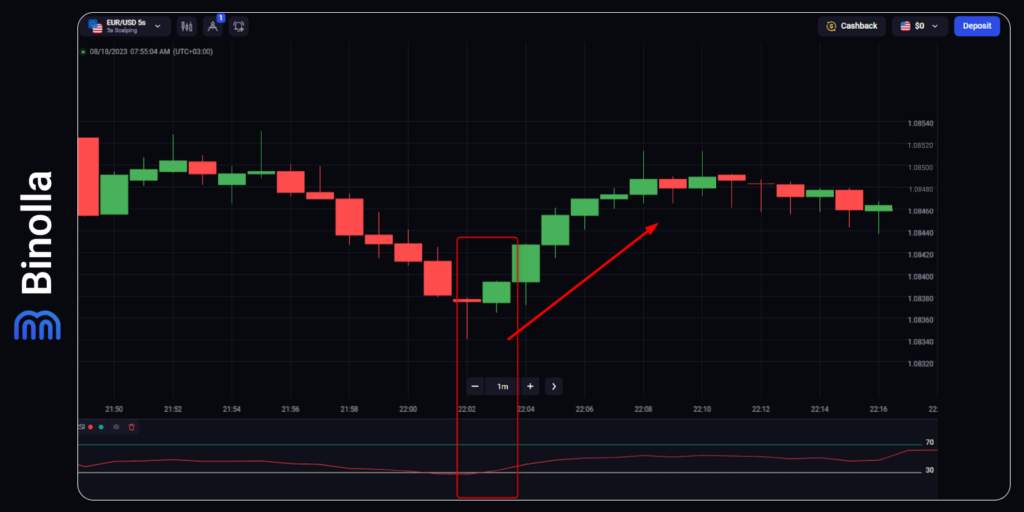
Technical indicators are commonly used in digital options trading. One of the examples of strategies that you can apply to buy fixed-time contracts is presented above. You can see the price reversal when the RSI indicator leaves the oversold area, which is below 30. Once the line goes above 30 again, you have a signal to buy a Higher contract.
There is one trick here that you may have noticed. Along with the RSI signal, there is a hammer pattern on the chart that also confirms bullish changes in the market. Therefore, you have two signals that complement each other. This situation is known as confluence. If you have two or more confluences, you can expect your signal to be two times stronger.
Therefore, when you conduct digital options trading and have doubts about what to do next and you have a signal that is provided by one of the indicators, you can always look at the chart and try to find confluences, and if you have at least one, such a signal is much stronger.
Should I Perform Digital Options Trading?
This is the question that many beginner traders may ask when they enter the industry. There are plenty of choices nowadays, as you can go on crypto exchanges and buy digital coins there or even go directly to the stock market and purchase some shares to create your portfolio and earn dividends. Why choose fixed-time contracts with this huge variety of assets and financial instruments that can be traded today?
- High payouts for a single trade. One of the most evident advantages of digital options trading is that you can earn high payouts on your investments. Each trade may bring you up to 95% of the amount that you have put at risk. For comparison, investments’ average yield is 30% per year. If you are doing options trading, you can earn $95 from each $100 if you make the right prediction of the market;
- Digital options trading offers predetermined risks. This is a very important feature that allows you to focus less on what is going on after the trade is placed. If you are trading leveraged products like FX or stocks, you can lose all your money if you don’t manage your risks properly. In digital options trading, you can’t lose more than you have invested in a single trade;
- Options trading flexibility. When performing fixed-time options trading, you can choose between a variety of expirations and assets. Whether you are a short- or even an ultra-short-term trader, you can find something that suits your interests. As for underlying assets, you can pick from a variety of currencies, stocks, commodities, cryptocurrencies, etc. Therefore, you can build your own trading portfolio and make it diversified from any point of view.
Useful Tips and Recommendations for Future Fixed-Time Options Traders
Now that you know a lot about the nature of digital options, their main features, and advantages, and even have some strategies at hand that you can apply right away, we will provide you with some useful recommendations that may help you to make your trading process smoother or even improve your options trading performance:
- Curb your expectations about trading. First, you should think about what you expect from digital options trading. Many traders make a terrible mistake when they expect beyond-clouds profits, especially in the first couple of months. It doesn’t mean that you can’t have it randomly if you place a lot of money in one trade and this deal ends in money. However, you should be realistic about your trading career and set only down-to-earth goals;
- Focus on certain assets first. You may have heard about digital options trading diversification and its big role in a successful trading career. However, if you are a beginner, we recommend you put on blinders and use only one asset. This will allow you to get familiar with it and learn more about its behavior in various market conditions. Meanwhile, you can look at other assets and discover their features and advantages to add them to your trading portfolio in the future;
- Don’t overwhelm your trading strategy. There are a lot of technical analysis tools that you can use in your trading routine. Binolla, for instance, offers over 50 various indicators and drawing tools. However, you should bear in mind that this variety is for choosing the most appropriate ones and not for crowding charts and adding them for no purpose;
- Have enough free practice. Trading in a demo mode is of huge importance, especially for beginners. Thus, you should use this opportunity to practice your skills. However, you should keep in mind that a demo account is both good and bad. If you stay for too long in a risk-free mode, you may get used to it and have problems switching to real-money mode. Use a demo account wisely;
- Use proper money management and start small. We have already mentioned a 5% money management rule. However, for beginners, this percentage may be even lower, especially when you open your very first trades.
Conclusion
Fixed-time options trading is a very popular way to start with financial markets for those who have never dealt with them before. Those contracts are simplified, which allows traders to ignore some aspects and focus on their strategies and trading systems.
Digital options trading has quite a long history that began in 2008 on the wave of the financial crisis that initially burst in the United States and later covered the rest of the world. With those contracts, a lot of people managed to join financial markets and build their careers in this niche.
In general, digital options trading is suitable for all traders regardless of the assets they use as those contracts can be bought on all types of assets, including popular cryptocurrencies.
FAQ

What is Digital Options Trading?
This is a process of buying contracts aimed at profiting from their underlying asset’s price difference.
How to Perform Digital Options Trading Profitably?
To do that, you need to learn how to analyze markets and create a strategy that you will use in your daily routine. With this strategy, you will have a tool that will help you predict the direction of price movement.
Is Digital Options Trading Good for Beginners?
Yes, it is. Digital options trading was designed for beginners with simplified conditions and an understandable nature. Moreover, with this type of option trading, you can have massive earnings that are incomparable to any other type of financial instrument.
What is the Difference Between the Strike and Expiration Price in Digital Options Trading?
The main difference between them is that the first reflects the asset’s price when you buy an option and the second is the price at the expiration moment, when all the calculations, including your payout are made.
